The Church of Saint James the Apostle and Saint Mary Magdalene
The Lady Chapel
The High Altar, Chancel,
Nave & Pews
The Roode Cross
The Holy Eucharist
The North Aisle & Vestry
Stained Glass, Brasses, Memorials
The Font
Pulpit, Registers & Plate
The Church-1787
St James Flag
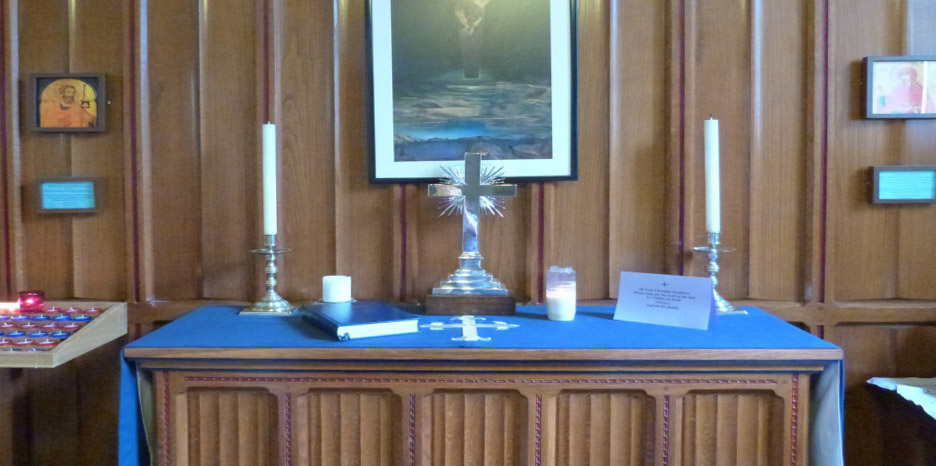
The Lady Chapel
The Lady chapel along with the church spire date from the 13th Century. The chapel contains small fragments of medieval stained glass from before the reformation it was the scene of a dispute over the right of one Richard Barrow of Field Court (Hardwicke) who wished to attend “Divine Service” at Quedgeley Church, but who was ejected from the building by one John Porter (Churchwarden) in 1512. In the 18th Century this South Aisle belonged to the Barrows and shortly afterwards it became associated with the Hayward family. Several monuments exist to members of the Hayward family. It has a fine Elizabethan barrelled panelled roof with carved bosses and coats of arms of the Arnold and Barrow families. Sadly this roof is in need of preservation and restoration.
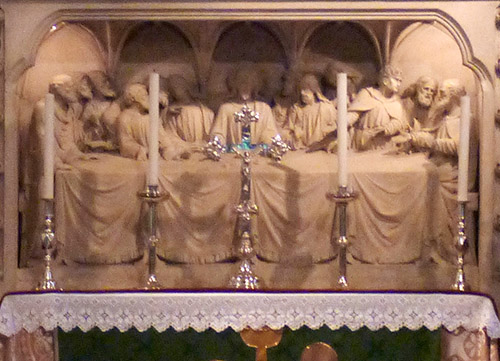
The High Altar
The stone reredos above the High Altar is a sculptured representation of the Last Supper, a gift of the Revd T Peters of Earlington for the re-opening of the church in 1857. Mrs Curtis Hayward presented a rich altar cloth at the same time.
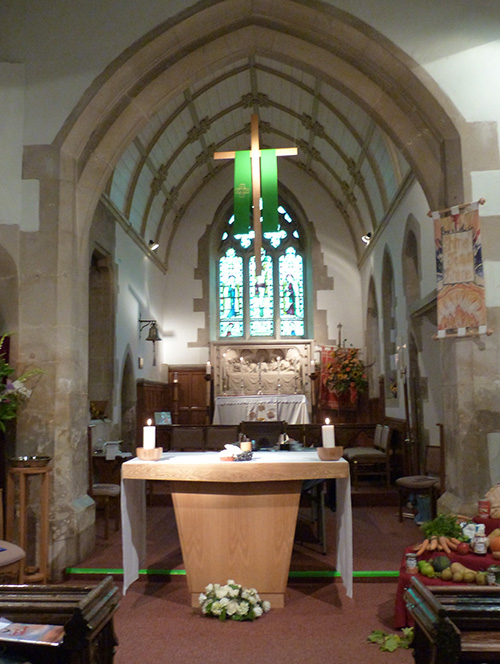
The East Window
The original east window can now be seen in the vestry. It was positioned there in 1856 during the last major restoration of the church.
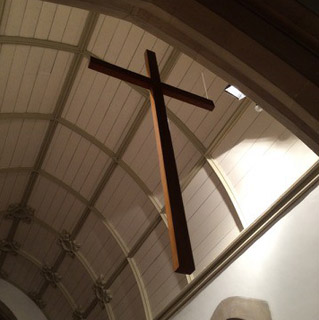
The Roode Cross
The Roode cross at the Chancel was given by Martin and Caroline Bland in 2014 and hangs above the nave altar given in memory of the Harvey family.

The Holy Eucharist
The Holy Eucharist celebrated at the nave altar with the Reverend Caroline Bland, Fr Ian Robb (Assistant Priest) Fr John Ward (Rector) And Fr Hugh Broad (Assistant Priest).
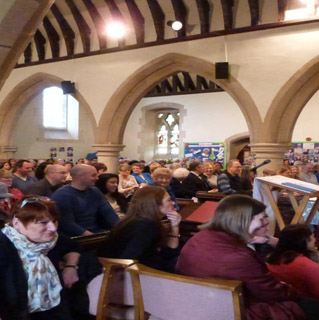
The Nave
View of the nave from the Lady Chapel, the pews were added in 1857.
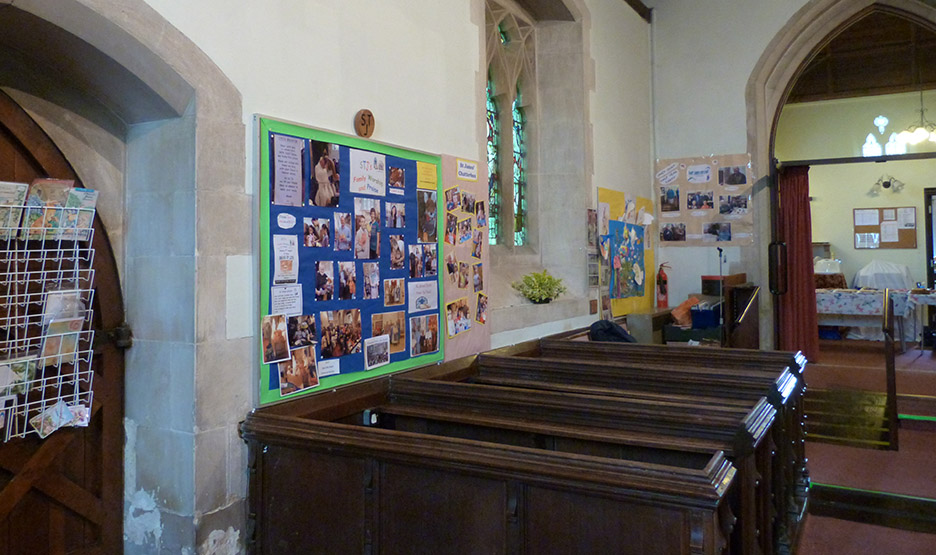
The North Aisle and Vestry
This was improved and added to the church in 1856, to house the increased population of the village of Quedgeley. The pews are of a simple structure. many in oak, with some richly carved features.
The north aisle and the vestry beyond were added between 1887 and 1891. An inscription on the vestry walls reads:
The nave and chancel of this Church were re-built and the North Aisle added in the year of Our Lord 1857.W.F.E. Knollys.
- Rector; J. Curtis-Hayward & James Browning – Churchwardens.The vestry also contains the original east window.
Stained Glass
The East Window was made by Messrs Hardman , as a memorial gift, and representing the Crucifixion and Resurrection. Another window in the chancel, also painted, is in memory of the Revd W Adams. The East Window in the south aisle (Lady Chapel) contains ancient medieval glass in restored tracery. The Windows in the North Aisle are by Woodyer and the West Window is by Kent.
Brasses
The Medieval brass in memory of Arthur Porter’s two daughters placed by him in the Church in 1532. There are several Bazett family brasses on the S W wall of the nave.
Memorials
There is an early memorial to Rychard Berow dated 1562 over the main entrance inside the Church. In the South Aisle is an elaborate mural monument, dated 1696 to William Hayward.
The Font

The font is a cylindrical 12th Century font encased in an octagonal ashlared casing with panels of gold and coloured tessarae, including blue forest stone. This was given by Revd Winstone Hayward for the re-opening of the Church in 1857.
Pulpit
Incorporates Jacobean woodwork, carved.
Registers
These date from 1559 and are complete apart from 1751-1812.The registers are deposited with the Gloucester registry office.
Plate
This includes silver Alms dish, 1674, silver chalice 1694, paten 1697.
The Church of Saint James from the north in 1787

This picture (above) is from a “copper plate engraving” and shows the church minus the north aisle. It shows the existence of a porch and a clock face on the north facing side of the tower spire. The engraving shows the original east window (now in the vestry) in its original place.
The photo below shows the church from the same position today.
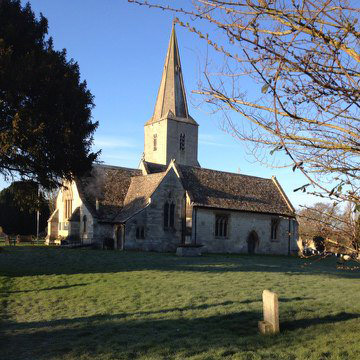
The Saint James Flag

The feast day of Saint James’ is celebrated on 25th July.
Saint James’ is patron saint of Labourers. James grew up by the sea – Lake Galilee. James was a disciple of Jesus and a fisherman by trade. He also had a brother called John.It seems the two brothers, James and John may have been known for having rows with each other. Jesus had a nick name for them ‘The Sons of Thunder.’
Following Jesus’ death James continued the teachings of Christ but unfortunately Herod committed James to execution (Acts 12). James became the first of the disciples to die for his faith.
The shell is a subject of legend. It is said that when the body of St. James was being returned to Spain, a knight fell from a cliff on shore and drowned as the body passed by. When the knight miraculously arose alive from the water, he was covered in scallop shells.
From there on the scallop shell has been associated with Saint James’. The flag at Saint James’ Church Quedgeley shows 3 scallop shells on a red background.
The feast day of Saint Mary Magdalene is celebrated on 22nd July.
Mary Magdalene travelled with Jesus as one of his followers. She is said to have witnessed Jesus' crucifixion and resurrection. Within the four Gospels she is named at least 12 times, more than most of the apostles. During the middle Ages she developed a reputation in Western Christianity as being a repentant prostitute or loose woman, however, these claims are not supported by the canonical gospels.
The gospel of Saint Luke says that seven demons had gone out of her, and Saint Mark says that Jesus cast seven demons out of her. She is most prominent in the narrative of the crucifixion of Jesus Christ at which she was present. She was also present two days later, immediately following the Sabbath, when, according to all four canonical Gospels she is the first person to testify to the resurrection of Jesus.
Mary Magdalene was present from the "beginning of a movement that was going to transform the West" and was also known as the "Apostle to the Apostles".
